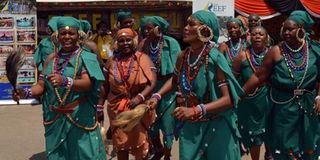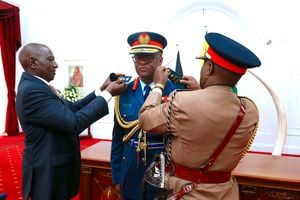New release gives Coast music verve

Kemore dancers entertain at the Mama Ngina grounds during the Mombasa International Cultural Festival on August 23, 2014. Ketebul Music launched its sixth CD focusing on coastal music during the four-day festival. PHOTO | KEVIN ODIT |
What you need to know:
- During the Mwanzele dance of the Mijikenda, dancers stamp their feet, sing, clap and shake the uteo, a round tray made of plaited leaf-strips, accompanied by ndema, a metal ring beaten by a rod.
- Taarab, the popular Swahili wedding music, is well represented on the album with the group Mombasa Taarab performing a rendition of the classic Kasha.
- During a musicians’ workshop in Nairobi in 2012, Mombasa-based singer Nyota Ndogo and Mohammed ‘Badi’ Ahmed of the group Nairobi Melody got together and wrote a song called Mahari.
Another milestone in the decade long history of the Spotlight on Kenyan Music was marked last week with the launch of the sixth volume of music from the project during the Mombasa International Cultural Festival.
The Musical Waves from the Kenyan Coast is an audio CD and DVD, supported by Alliance Francaise and various partners, showcasing the rich sounds of communities living along the Kenyan coast.
The rhythms come from the Boni of Lamu, the Mijikenda and the Swahili from Kilifi, Mombasa and Kwale and the Taita and the Taveta communities from the Taita Taveta County. The songs are a fusion of musical styles from the Coast including Mwanzele, Mdundiko, Taarab, and Chakacha with guitars, keyboards, saxophone and other contemporary instruments.
During the Mwanzele dance of the Mijikenda, dancers stamp their feet, sing, clap and shake the uteo, a round tray made of plaited leaf-strips, accompanied by ndema, a metal ring beaten by a rod. This style can be heard from the group Mzinga, in their song Muche Fauzila, the story of a man who is struggling to win the affections of a girl called Fauzila.
Zigidigi (thunderstorms in Chidigo) plays mdundiko, the traditional music from the Digo that is mainly performed at weddings. The music and dance is based on drums called the maboomboom, the chivoti (the flute) and a wind instrument known as gunda.
Their’s is a song about a jilted man called Matano wa Mwachiti who has been rejected both by the woman he loves and by her parents, too.
POPULAR MUSIC
Taarab, the popular Swahili wedding music, is well represented on the album with the group Mombasa Taarab performing a rendition of the classic Kasha.
The song, first recorded in the 1950s and made popular in contemporary times by the Mombasa Roots Band, is typical of taarab songs loaded as they are with Swahili riddles and metaphors (mafumbo). Kasha is literally a strongbox, but in this context “the locked safe” refers to protecting a lover from the seduction of others.
Mombasa Taarab is a group founded in 2000 by violinist, Seif Omar, a veteran of the taarab scene at the coast of Kenya who has played with many ensembles. While modern taarab is now played with synthesisers and keyboards, this group still plays the music in the original style with classical instruments like the tashkota (a stringed instrument of Japanese origin)
Another taarab outfit appearing on the album is Lelele Africa, a collection of seasoned musicians from both Mombasa and Lamu, who have performed in various groups since the 1970s. They adopt the melody of a popular folk song from the Bajun community in Lamu in their recording Kuliepuka Shari featuring vocals by the charming singer Mwanate Kibwana.
During a musicians’ workshop in Nairobi in 2012, Mombasa-based singer Nyota Ndogo and Mohammed ‘Badi’ Ahmed of the group Nairobi Melody got together and wrote a song called Mahari.
A year later that song, a seductive lyrical interplay between two lovers, was recorded at the Ketebul Music Studio for the Spotlight project and stands out as one of the highlights on the newly released album.
ACCOMPLISHED MUSICIAN
Nyota herself also appears on the album with an individual cut called Dawa that is enriched with the accordion of French performer Vivian Arnoux recorded when the two worked together on the project “Reviving the Accordion” in Nairobi in 2012.
One of the most accomplished musicians appearing on this year’s Spotlight is Mzee Mwatela, who was among Kenyan performers at the historic Second World Black and African Festival of Arts and Culture (Festac 77) in Nigeria in 1977. His career has taken him on tours to Japan, Italy, Israel and the UK, though his music has sometimes come at a cost.
As Mwatela sings in Dzunyi Ysetse, he’s been shortchanged by some promoters, whom he compares to eagles that lift their prey and fly away never to return.
Other highlights on the album include the hip swivelling chakacha on Pararira by the young artist Mr.Bado from Malindi who was among Kenyan performers at the Smithsonian Folklife Festival in Washington D.C in June.
The Nairobi-based guitarist Kombo Chokwe and the Afro Simba Band who backed up all the musicians at the launch concert in Mombasa and also made the recent trip to the US contribute a catchy Giriama song called Ga Dunia.
Since the project was started in 2005, by the Alliance Francaise, the Spotlight on Kenyan Music project has produced a wealth of the country’s diverse musical talent, including Sauti Sol, Makadem, Juma Tutu, Benta Agen’ga, Ronald Ontiri, Michel Ongaro, George Mutinda, Gargar and Doris Chepchumba.
This latest collection of music offers an opportunity for often unheralded musicians to gain the limelight by adding a modern edge to musical styles that have existed for generations.



